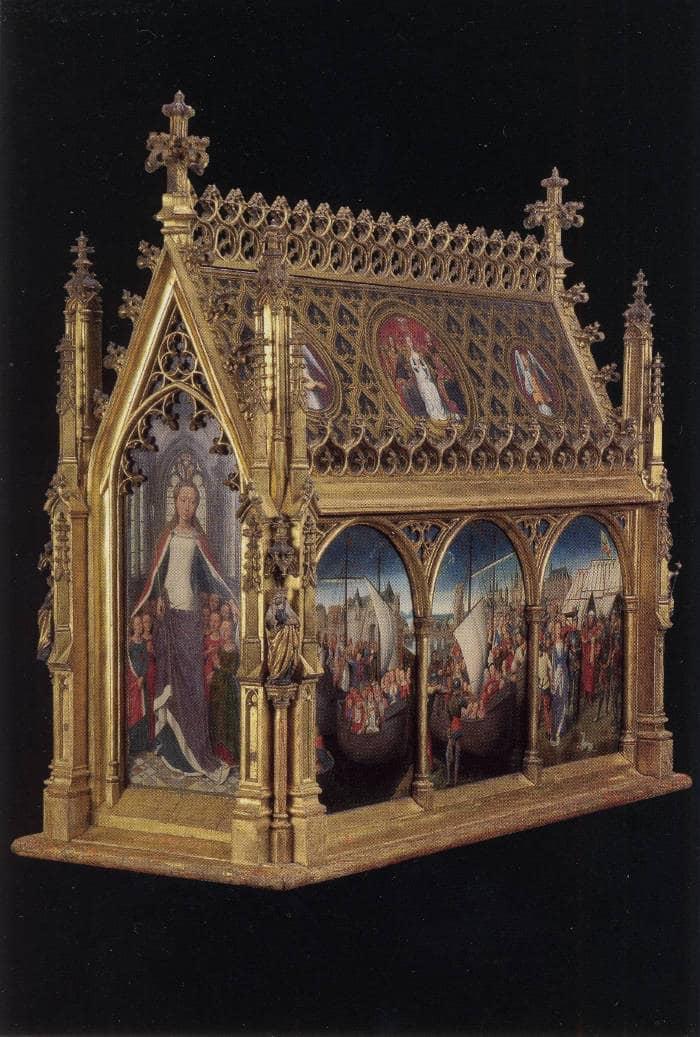St. Ursula Shrine
St. John's Hospital Memling Museum of Bruges

The Saint Ursula's Shrine is a shrine intended to preserve the relics of the Eleven Thousand Virgins and a number of saints, as well as some memorabilia brought back from the Holy Land, of which the painter Hans Memling decorated the four sides with a set of paintings, and six medallions on the roof.
The paintings tell the story of St. Ursula. It is one of the great compositions of the painter miniaturist. The work dates from . The shrine was designed and was preserved for St. John's Hospital Memling Museum, of Bruges.
Memling follows step by step the narrative Legenda Aurea by Jacobus de Varagine, a translation of which appeared in .
In the following article, we directly contrast the text of Legenda Aurea with representations by Hans Memling. We believe that in this way their quality will only become more striking.
The following article is a direct comparison of the text of Legenda Aurea and Hans Memling's representations.
the Eleven Thousand Virgins
The passion of eleven thousand virgins was hallowed in this manner.
In Britain was a christian king named Notus or Maurus, which engendered a daughter named Ursula.
This daughter shone full of marvellous honesty, wisdom, and beauty, and her fame and renomee was borne all about.
And the king of England which then was right mighty, and subdued many nations to his empire, heard the renomee of her, and said that he would be well happy if this virgin might be coupled to his son by marriage.
And the young man had great desire and will to have her.
And there was a solemn embassy to the father of Ursula, and promised great promises, and said many fair words for to have her; and also made many menaces if they returned vainly to their lord.
And then the king of Britain began to be much anxious, because that she that was ennobled in the faith of Jesu Christ should be wedded to him that adored idols, because that he wist well she would not consent in no manner, and also because he doubted much the cruelty of the king.

And she, that was divinely inspired, did so much to her father that she consented to the marriage by such a condition, that for to solace her he should send to her father ten virgins, and to herself, and to those ten other virgins, he should send to each a thousand virgins, and should give to her space of three years for to dedicate her virginity, and the young man should be baptized, and in these three years he should be informed in the faith sufficiently, so that by wise counsel, and by virtue of the condition made, he should withdraw from her his courage.

But this youngling received this condition gladly, and hasted his father and was baptized and commanded all that Ursula had required should be done. And the father of the virgin ordained that his daughter, whom he most loved, and the others that had need of the comfort of men and service, ordained in their company good men for to serve them.
Then virgins came from all parts, and men came for to see this great company, and many bishops came for to go with them in their pilgrimage, among whom was Pantulus, bishop of Basle, which went with them to Rome, and returned from thence with them and received martyrdom. S. Gerasine, queen of Sicily, which had made of her husband that was a cruel tyrant a meek lamb, and was sister of Maurice the bishop, and of Daria, mother of S. Ursula, to whom the father of S. Ursula had signified by secret letters. She, by the inspiration of God, put herself in the way with her four daughters, Babilla, Juliana, Victoria and Aurea, and her little son Adrian, which, for love of his sisters, went in the same pilgrimage, and left all in the hands of his own son, and came into Britain, and sailed over sea into England.